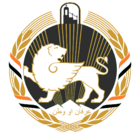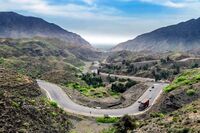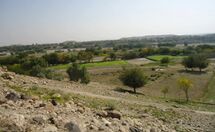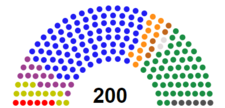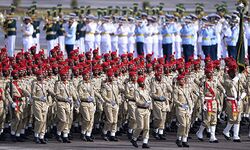Gulbistan: Difference between revisions
No edit summary |
No edit summary |
||
| Line 163: | Line 163: | ||
===Modern Gulbistan=== | ===Modern Gulbistan=== | ||
==Geography== | ==Geography== | ||
Gulbistani geography ranges from the dry Tamyun desert to the... | |||
{{multiple image | {{multiple image | ||
|align=center | |align=center | ||
Revision as of 07:43, 15 March 2021
This article is incomplete because it is pending further input from participants, or it is a work-in-progress by one author. Please comment on this article's talk page to share your input, comments and questions. Note: To contribute to this article, you may need to seek help from the author(s) of this page. |
Federation Of Gulbistan | |
|---|---|
| Motto: عرفان او وطن "Erfān aw Watan"
"Irfan and Homeland" | |
| Anthem: د روان ـنازوشان Da Ravān Zazošān" "Spirit Of Zaxosios" | |
Location of Gulbistan(dark blue) in Coius(light blue) | |
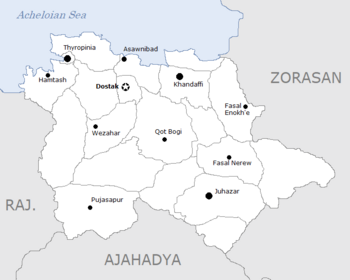 | |
| Capital | Dostak |
| Largest City | Thyropinia |
| Official languages | Mershi |
| Recognised regional languages | Abali and others |
| Demonym(s) | Gulbistani |
| Government | Federal Presidential Republic |
• President | Omar Sherzai |
| Legislature | Federal Congress |
| Tribal Jirga | |
| People's Jirga | |
| Establishment | |
• Independence From Ravnia | 1936 |
| Population | |
• 2020 census | |
| GDP (PPP) | 2020 estimate |
• Total | |
• Per capita | $4,519.87 |
| GDP (nominal) | 2020 estimate |
• Total | |
• Per capita | $4,375.99 |
| Gini (2020) | 41.5 medium |
| HDI (2020) | 0.642 medium |
| Currency | Wazen (WZN (وزن)) |
| Date format | dd.mm.yyyy |
| Driving side | right |
| Calling code | +109 |
| Internet TLD | .pa |
Gulbistan (Mershi: ګلبستان; Gulbistān ), officially the Federation Of Gulbistan (Mershi: د ګلبستان فدراسیون; Da Gulbistān Federāsion): is a Federal Presidential Republic located in northeast Satria on the continent of Coius. It is bordered by Rajyaghar to the west, Ajahadya to the south, and Zorasan to the east.
Gulbistan was settled by humans over 60,000 years, but the first major settlement was the ancient city of Amtes, today known as Hamtash. By the year 2500BC Satro-Eucleans arrived in the region from the east, and dominated the region. The Amstian Civilization would dominate the region until the arrival of settlers from Piraea. One of the city-states founded, Thyropinia, would grow to be massive in scale and dominate trade routes of the southern Acheloian Sea. During the rise of the Solarian Empire, Thyropinia became fully independent of the Piraean homeland and became an empire of its own, known as the Thyropinian Kingdom, they would conquer almost all of modern-day Gulbistan and establish a unique cultural fuse between Piraean, Amtsian, and Satrian cultures. The Kingdom would come to an end around 50AD due to invasion from the Sangma Empire, who ruled for a very short period.
(TBD HISTORY)
In 1953, a coup would overthrow the Emir and establish the Republic Of Gulbistan. These rebels were led by Pason Paywastun, a radical whose ideology of Mershizationism was inspired by Sattarism in Pardaran. Paywastun was heralded as a hero by the people. Just after coming to power, the 1953 Thyropinian Crisis began, where in the end he was able to successfully force Paretia to give Thyropinia to Gulbistan. He would hold anti-colonialist and nationalist stances, and would see good relations with their neighbors in Pardaran. This mass support would dwindle the 1970s, when Paywastun would undergo a change in his positions. He would begin massive modernization, including state secularization. This led to massive unrest in the south. In 1984, Paywastun would die and he would be replaced by Yusef Marri. Tribal leaders led by Darwish Wajia would agree to overthrow the government and incite the tribal peoples into rebelling against Marri. Marri would be ousted in 1987 and replaced with Hamid Zazozai. However, after another few years of fighting Zazozai gave up and fled to Zorasan. This allowed for the establishment of the Federation, with Darwish Wajia elected to be the first president.
Etymology
History
Prehistory
Antiquity
Irfanic Normalization
Medieval Period
Muhabid-Khandaffid Era
Togoti Invasions
Zemani Empire
Colonization
Ravnian Satria
Great War
Emirate
Republic
Civil War(1985-1995)
Modern Gulbistan
Geography
Gulbistani geography ranges from the dry Tamyun desert to the...
Climate
Flora
Fauna
Government and Politics
Gulbistan today is a Federal Presidential Republic where a President is both head of state and head of government. The government's structure is laid out in the Constitution Of The Grand Jirga written in 1995. Its government contains an executive brance, legislative, and judicial branch. Federalism in Gulbistan is engrained into the constitution due to the need for local autonomy of the tribes and the minority groups that inhabit the country. Since 20
Government
The government of Gulbistan is divided into three branches. The executive branch of the government is led by the president, who holds both roles of head of government and head of state as well as being the commander-in-chief of the Military Forces Of Gulbistan. He is responsible for foreign policy, as well as appointing ministers into office. The job of the president and his ministers is to execute laws and run the country.Pre Since 2007, Gulbistan has had one president, Omar Sherzai
Political parties
Gulbistan has a multitude of political parties, but the largest by far is the Patriotic Front. The PF was created in 2011 by Omar Sherzai as way to split off from the Gulbistani National Party, of which he formerly was a member of. The PF sits in a coalition government alongside the Gulbistani National Party, High Tribal Party, and two independents. This coalition's ideology is mostly center-right. In 2017, the government coalition was able to use a constitutional clause to cease presidential elections, effectively keeping Omar Sherzai in power until the Abalistan-Tobadad insurgency is dealt with. There are also a few opposition parties, but the main one being the Tribal-Irfanic Coaliton. This party, led by Darwish Wajia, maintains a position of traditionalism and Irfanism as well as foreign isolationism and self-dependence. Other smaller oppositional parties include the Gulbistan Irfanist Union, the Party Of Principle, the Tulyata-Satristan Party, and the Gulbistan Socialism and Reform Party.

